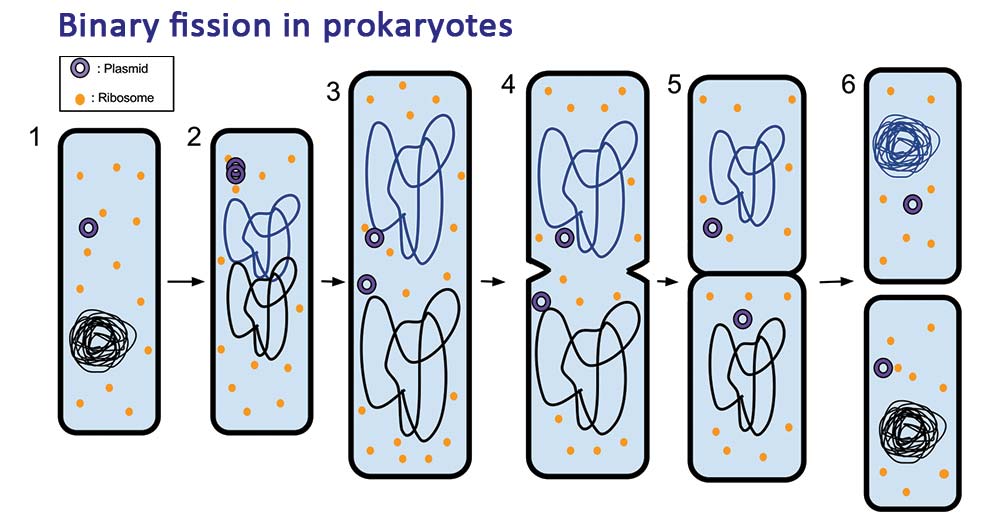Plant Physiology II Notes 2023 MSc Botany 3rd Semester.
- Binary fission is a type of asexual reproduction where a single living cell or an organelle grows twice its size and then splits into two identical daughter cells, where each of these daughter cells has the potential to grow into the size of the original cell or organelle.
- Binary fission differs from other types of fission in that; only two parts are formed from a single entity.
- This form of reproduction is called asexual as the process doesn’t involve the formation or fusion of gametes.
- Because binary fission is a type of asexual reproduction, the daughter cells formed have the same genetic material as their parent cell.
- Binary fission is the mode of reproduction in many prokaryotes including, archaea, cyanobacteria, eubacteria, and some eukaryotes like amoeba and Paramecium.
- Some cell organelles like mitochondria also undergo cell division by the process of binary fission.
- In order to remain viable and competitive, a bacterium must divide at the right time, in the right place, and must provide each offspring with a complete copy of its essential genetic material.
Plant Physiology II Notes MSc Botany 3rd Semester
| Topic | View |
|---|---|
| Plant Physiology 2 | Download_View |
| Plant Physiology 2 Mid Past Paper | Download_View |
| Hofler Diagram | Download_View |
| Plant Physiology 2 | Download_View |
Archeologists Unearth Historically Significant Mummies in Peruvian Capital.Plant Physiology II Notes 2023 MSc Botany 3rd Semester
Steps/Process of Binary Fission
Binary fission in prokaryotes

Figure: Binary fission in prokaryotes. Image Source: .
- Before binary fission, unlike human cells in which the genetic material is present inside a nucleus, the genetic material of the prokaryote (chromosomes) is present in a specialized region of the cell in the cytoplasm as a nucleoid.
- The chromosomes then undergo replication starting from a point in the chromosome called, the origin of replication. The origin then divides, and as the replication continues, the two origins move towards opposite ends of the cell, pulling the chromosomes with them.
- Once the replication is completed, different types of proteins working as cell division machinery assemble at the future division site (at the center of the cell).
- One of the essential proteins in this process is the FtsZ protein which forms a ring-like structure at the center of the cell.
- This process is essential to ensure that the division splits the cytoplasm and doesn’t damage the genetic material.
- Now, for the division of the cytoplasm, the membrane pinches inwards forming a septum (new cell wall) forms down the middle of the cell.
- Finally, the septum divides itself to form two independent cells.
- Crenarchaeota having neither a cell wall nor the FstZ protein, however, utilizes a primitive mechanism involving different proteins called the ESCRT-III system.
Binary fission in eukaryotes
- Although most of the eukaryotes undergo sexual reproduction, some protozoans like amoeba reproduce by binary fission and cell division in some organelles within the eukaryotic cells occurs in a similar bacteria-like fashion.
- The process of binary fission in these cells is the same as that of prokaryotes involving the FtsZ protein.
- Cell organelles like mitochondria and chloroplasts divide by binary fission which gives the basis for the Endosymbiotic theory, which explains that the prokaryotes have evolved into the present-day mitochondria.
Types of binary fission
Binary fission is of four types based on the plane of division of the cytoplasm:
- Irregular Binary Fission
- In this case, the division of cytoplasm (cytokinesis) can occur in any plane but is mostly perpendicular to the plane of division of chromosomes (karyokinesis).
- This type occurs in organisms like an amoeba.
- Transverse Binary Fission
- In transverse binary fission, cytokinesis occurs along the transverse axis of the cell.
- This type of division occurs in ciliated protozoans like Paramecium.
- Longitudinal Binary Fission
- Here, the division of cytoplasm occurs along the longitudinal axis of the cell.
- This type of division occurs in flagellates like Euglena.
- Oblique Binary Fission
- The division of the cytoplasm, in this case, occurs obliquely (i.e. left and right oblique).
- This type of division occurs in dinoflagellates like Ceratium.
Examples of organisms that use Binary Fission
- A group of different organisms, including both prokaryotes and eukaryotes, divide by binary fission.
- Most of the bacteria reproduce by this process. The process involves the division by utilizing the FtsZ protein, including chromosomal replication, chromosomal segregation, and cell splitting.
- In protozoans like amoeba, Paramecium, Euglena, however, the process might differ in cell splitting and in how the cytoplasm divides.
- Organisms that reproduce by binary fission include Bacillus subtilis, B. cereus, B. pumilus, Escherichia coli, Clostridium perfringens, Corynebacterium diphtheriae, Amoeba, Paramecium, Euglena, Ceratium, etc.
Read Also:
Binary Fission vs Mitosis
| Characteristics | Binary Fission | Mitosis |
| Occurrence | This occurs in prokaryotes and some eukaryotes. | This occurs only in eukaryotes. |
| Mechanism | In binary fission, spindle fibers are not formed. | In mitosis, the division is supported by the formation of spindle fibers. |
| Stages | Binary fission involves three stages, namely, chromosome replication, chromosomal segregation, and cytoplasm splitting. | Mitosis involves four stages; prophase, metaphase, anaphase, and telophase. |
| Product | This process results in the formation of two identical daughter cells, both with the same genetic content as the parent cell. | This process also results in the formation of two identical daughter cells, both with the same genetic content as the parent cell. |
| Function | Binary fission is a type of asexual reproduction. | Mitosis is involved in cell growth (numbers) in multicellular organisms. |
